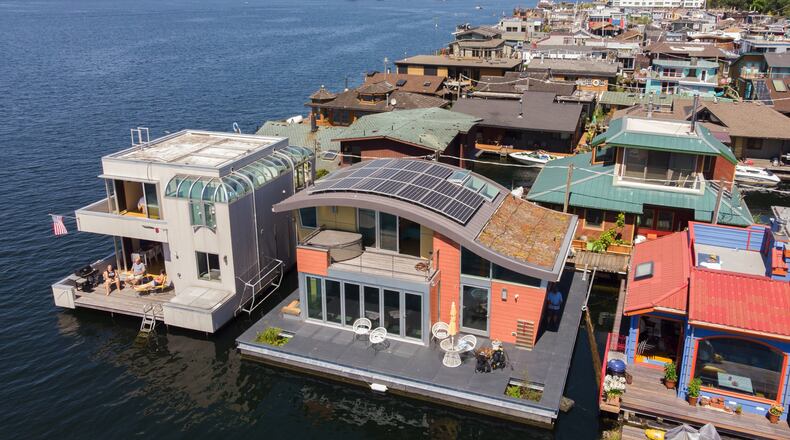Bill included.
He once owned a turn-of-the-century floating home at this same jaw-droppingly scenic slip. But while he was renting it out, a lighted cigarette dropped below the deck and ignited a devastating fire, says Michelle.
The unfortunate neighborhood aftermath: “The burnt crisp of a house had to sit here,” she says. “The slip can’t be left open more than 30 days.”
The awesome neighborhood aftermath: Like a really good neighbor, Michelle and Bill consider the whole lake — and really, the whole planet — their community, so their new LEED Platinum-certified floating home is a contemporary dock-party addition of super-sustainable, and super-courteous, design.
Some of its environmental elements and approaches might sound familiar: maximum insulation/minimum air leakage. Minimum maintenance/maximum durability. Salvaged, recycled, rapidly renewable materials. Low-E triple glazing. LED light fixtures. ENERGY STAR appliances. Water-efficient fixtures.
Admirable and inspiring, for sure, but even better, Michelle says: “We wanted to push the limits to what a houseboat could be.”
Alert the tug. There’s an awful lot of pushing going on here:
— Take the standing-seam metal roof, for example, and its sleek waterslide of a curve (originally conceived by designer Gloria Andrade, before architect Michelle, of Lanker Design, jumped on board). Not only does it pair with panoramic clerestory windows to open tourist-brochure Seattle views to neighbors across the dock; it also purposefully displays 5.32Kw of solar panels, and a vegetated roof system.
— Speaking of vegetation: There are floating islands attached to the floating home: planters filled with wetland plants — most native to Lake Union — and suspended in the water below the deck. (The composite deck is 45 percent open so light can get to the plants, Michelle says: “The more they propagate, the better.”) The islands are living oases of amazement and innovation. “Bill had come across floating islands when some friends who are environmental consultants went to California with him,” she says. “We have some water-quality issues on the lake and are in sore need of shoreline; so much has been lost.” These islands, in various sizes, let the root systems extend into the water, creating fish habitat. “The roots are not only cleaning the water, but the recycled plastic material the plants are growing in is like a sponge in an aquarium: Microorganisms are living in it, also. Pretty cool, I have to say.”
— It gets cooler. “Bill said, ‘I want an observatory for what these floating islands could do,’ ” Michelle says. And now, downstairs (there is a fully livable downstairs!), “The concrete float of the home becomes an observation room for studying these floating islands through a large underwater window,” she says. “We’re in 50-plus feet of water here. I see smallmouth bass more than anything else. I’m sure there’s more stuff than what we’re seeing.”
— Also cool, in a warming way: “a hydrothermal heating system basically powered from the lake,” Michelle says. In addition to a series of tanks, a heat pump and a pump-flow center, it involves a titanium plate suspended in the lake and a transfer fluid loop of Glycol, which she describes as “food-grade antifreeze” (it’s cooler than the lake). “It’s so great; it’s so constant. Whatever the temperature is outside, it’s the same in here. With forced air, there’s constant monitoring. Here we keep it at a set temperature, and it stays constant. For most of the year, what we get out of the lake is all we need for heat.”
— And, devastating as it was, that fire did not take everything. Twenty-two old-growth cedar logs, some 24 feet long and 3 feet in diameter, all part of the home’s original float, were salvaged, and are treasured. “They had been completely submerged and preserved, but were totally saturated,” Michelle says. “Once you get the water out, they’re pretty much clear cedar. All the wood in the house is salvaged from those logs. And we still have some.” You can see it in the custom coffee table Michelle designed; in the living area’s centerpiece sculptural element; in the upstairs master suite’s ceiling, built-in bedframe and drawer system; and, downstairs, in the Murphy bed, the storage area, the shelves and the sliding pocket door, and around a wine-storage rack.
About the Author
